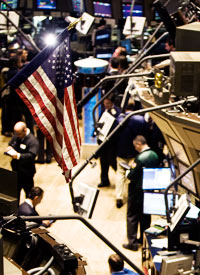 The Treasury Departmentâs $700 billion TARP (Troubled Asset Relief Program) isnât even off the ground yet. And here comes another new acronym representing an unprecedented intercession by the government: CPFF (the Commercial Paper Funding Facility).
The Treasury Departmentâs $700 billion TARP (Troubled Asset Relief Program) isnât even off the ground yet. And here comes another new acronym representing an unprecedented intercession by the government: CPFF (the Commercial Paper Funding Facility).
The Federal Reserve rolled out CPFF in an announcement this morning. As the Washington Postputs it, the new move will make the Fed âa major funder of a wide range of U.S. businesses facing imminent cash shortages.â
It is by all accounts a âradicalâ step for the Fed to take, to directly loan money to companies. As the New York Timesâ Floyd Norris quips, âSo we may soon have the government deciding which companies deserve short-term loans, and at what interest rates. Does this remind anyone else of central planning systems?â
But markets tumbled worldwide yesterday amidst the increasingly global financial crisis, and the commercial paper continued to worsen. Commercial paper is a form of short-term funding that many large companies rely on to finance their daily operations. With banks less and less willing to lend, rates have soared, leading to a near freeze in the market. As the Fedâs statement says, âThe Treasury believes this facility is necessary to prevent substantial disruptions to the financial markets and the economy.â
The rationale for the move, then, is clear. But given its unprecedented nature, there are plenty of questions.
First is the size of the intervention. At particular risk is the unsecured commercial paper market, as opposed to the comparably less risky asset-backed market. The current size of the unsecured market is about $683 billion (down from $835 billion in March), according to the Wall Street Journal. The total market for commercial paper, both unsecured and asset-backed loans, is well over $1 trillion. And the Fed says it will be buying both types. The statement offers no details on how much the government will be lending.
Second is how much the Fed is bending the rules to put the entity in place. As the Timesputs it, âThe effort is fraught with legal complexities.â Most importantly, the Fed is normally prohibited from buying assets that could lose money. (It usually requires that loans be backed by collateral.)
The governmentâs way around that, apparently, is to create a third-party entity (a âspecial purpose vehicle,â as the Fed puts it in the release) that will be doing the lending. The Fed and Treasury will be funding the SPV, which will in turn provide the loans. An additional obstacle, says the Times, is the possibility that the Fedâs brand new role could open it to âdifficult conflicts of interest, because it would be juggling the goals of protecting its investment portfolio with its traditional goals of promoting stable prices and low unemployment.â
And then thereâs the hairy problem of how the government will undo what has never been done before: âOnce the Fed steps in as a major player (major is required to have any impact), how does the Fed wean the market [off] its support?â asks economist-blogger Yves Smith.










